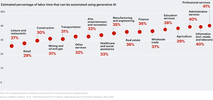- Joined
- 20 July 2021
- Posts
- 11,551
- Reactions
- 16,078
LOLAI will largely replace doctors, but it will be a way off. How it will work:
- log in to your GP or specialist from home.
- set up super hi-res webcam, mic, various peripherals such as blood pressure cuff, pulse oximeter, finger prick blood tester, urine tester, blood tester etc.
- All these peripherals will send data in real time to the GP's AI.
i wouldn't need to speak to a GP or AI if i already had that information , i am quite capable of assessing that myself
( already have urine test strips and a pulse oximeter )






